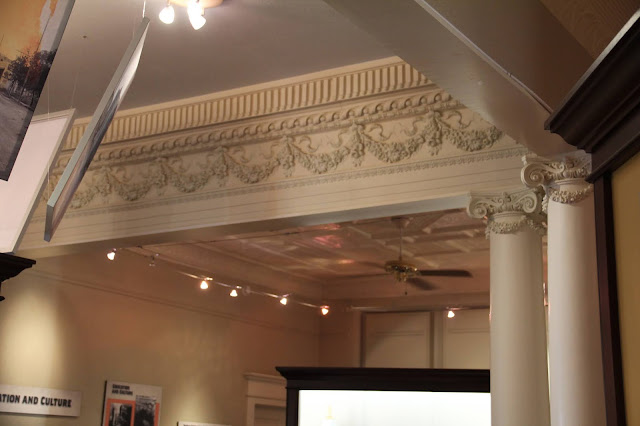 |
| 30 October 2020 |
On December 7, 1975, the Bell County Museum hosted its official opening and this building at 201 N. Main Street in Belton, Texas, began a new phase of life, welcoming visitors inside to explore the County's history. Citizens were already very familiar with it as it had been serving the community since 1905 as Belton's Carnegie Library. A new library had been built nearby, so the Bell County Commissioners granted use of the building to the Bell County Historical Commission.
The library traces its beginning to 1899, when the Women's Wednesday Club met for the first time in the parlor of a local hotel with the purpose of establishing a public library in the city of Belton. Each member donated a book, collecting 350 volumes to form the new library which opened its first location in a small room in the hotel. By the time the new Carnegie Library opened in 1905 the Club had collected over 1,500 books.
 |
| No other building in Belton exhibits the rich details of the library building. |
The Club began to seek funding from the Carnegie Foundation for a library building, sending letters in 1899, 1902, and 1903 asking for funds for a public library to be constructed in Belton.
After the 1903 request, the group was notified that if the City of Belton agreed by resolution of council to maintain a free public library at a cost of not less than a thousand dollars a year, and provide a suitable site, then Mr. Carnegie would be pleased to furnish $10,000 to help erect a free library for the city. By proper resolution and public subscription, citizens were able to provide the lot and Mr. Carnegie forwarded his personal check. (National Register of Historic Places nomination form)
The Carnegie Library building is considered to be significant in both its architecture and its indication of the cultural and educational awareness of Belton citizens. Other buildings in Belton constructed in this time period were designed with classical elements, but the library's Beaux-Arts classicism is considered to be "exuberant" in its design and ornamentation.
The little known firm of Smith and Moore designed the library. The contractor, Ben Lee, was well know to Belton for the local buildings he had constructed, one of which was the Bell County Courthouse.
 |
The two-story library consisted of an open first-floor room separated into four spaces by Ionic columns supporting an entablature adorned with very detailed garland swags. Each time I visit I am torn between gazing at the room's features and looking at the exhibits, it is mesmerizing!
 |
| Second floor auditorium/lecture hall stage |
The second floor was devoted to a large auditorium type room used for lectures and meetings. During the lean years of the Great Depression this room filled the need for a public meeting facility in Belton, hosting graduation ceremonies, plays, and USO shows among others. This room is still used for public meetings and other gatherings. The day I wandered in to make photographs they were either setting up or taking down an exhibit, so the pictures are a little cluttered.
 |
| Second floor meeting room. Both floors of the building feature pressed-tin ceilings |
The preservation minded city of Belton began a comprehensive renovation program in 1988 that restored the interior to its 1905 floor plan by the removal of walls that had partitioned the rooms into smaller spaces. In 2003 the Museum began the 3-year process of connecting the library and the next-door Guffy Building with a two-story central walkway. Today the main entrance into the library is through this walkway and the two buildings flow together seamlessly.
 |
| Original front entrance |
Of the 32 libraries built in Texas with funding from the Carnegie Foundation 13 exist today. The Belton library retains most of its original features due to the fact that very little modifications took place over the years it served as a library. The renovation and careful addition of the connecting walkway have served to preserve the library's original integrity.
 |
| Photograph taken in 1985, copied from the NRHP Belton Commercial Historic District nomination form. |
The property was listed on the National Register of Historic places on March 4, 1985.
.


